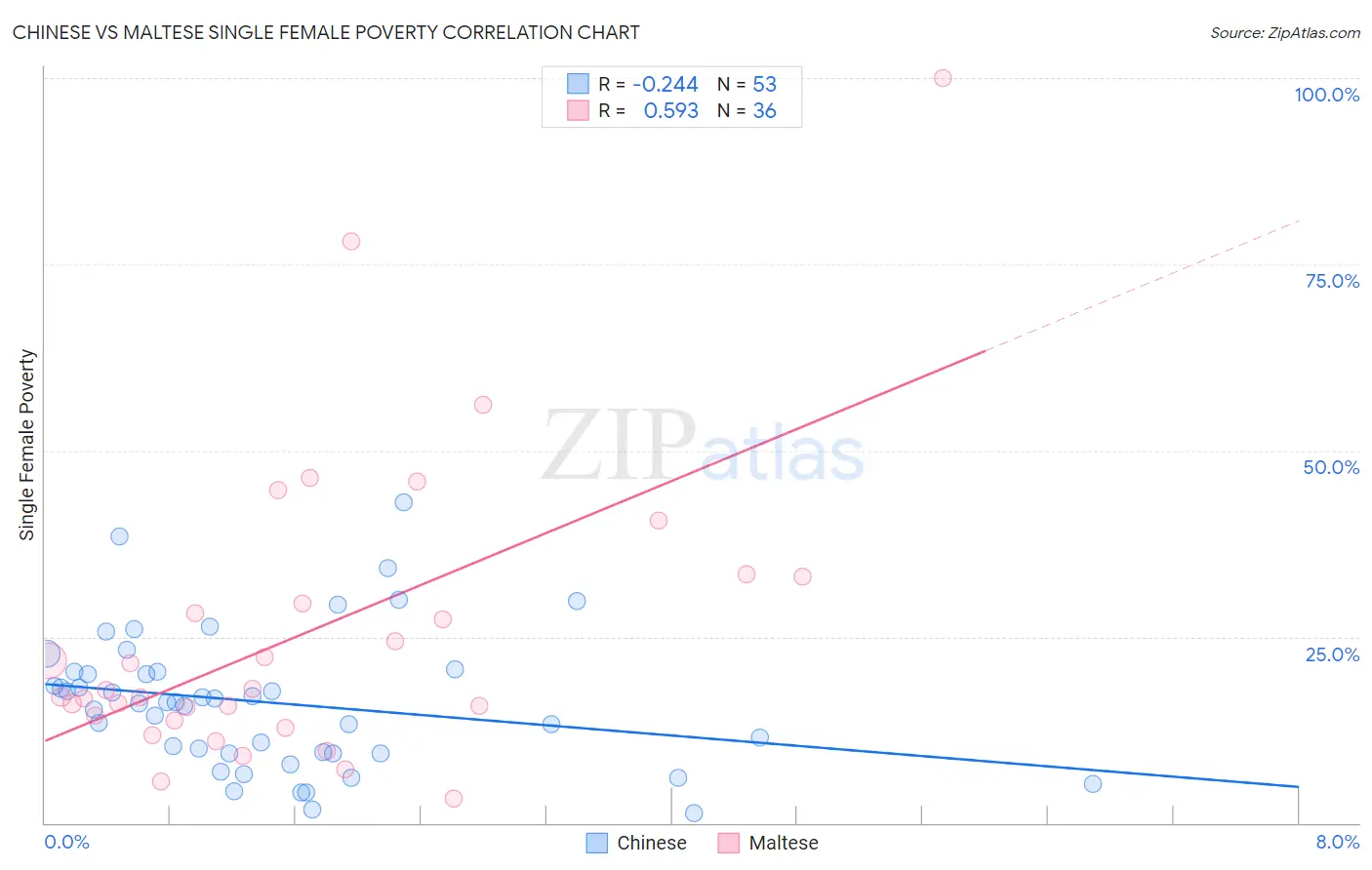Chinese vs Maltese Single Female Poverty
COMPARE
Chinese
Maltese
Single Female Poverty
Single Female Poverty Comparison
Chinese
Maltese
16.1%
SINGLE FEMALE POVERTY
100.0/ 100
METRIC RATING
1st/ 347
METRIC RANK
18.3%
SINGLE FEMALE POVERTY
100.0/ 100
METRIC RATING
21st/ 347
METRIC RANK
Chinese vs Maltese Single Female Poverty Correlation Chart
The statistical analysis conducted on geographies consisting of 64,651,041 people shows a weak negative correlation between the proportion of Chinese and poverty level among single females in the United States with a correlation coefficient (R) of -0.244 and weighted average of 16.1%. Similarly, the statistical analysis conducted on geographies consisting of 125,419,200 people shows a substantial positive correlation between the proportion of Maltese and poverty level among single females in the United States with a correlation coefficient (R) of 0.593 and weighted average of 18.3%, a difference of 13.2%.

Single Female Poverty Correlation Summary
| Measurement | Chinese | Maltese |
| Minimum | 1.3% | 3.3% |
| Maximum | 43.0% | 100.0% |
| Range | 41.7% | 96.7% |
| Mean | 16.1% | 25.4% |
| Median | 16.1% | 17.4% |
| Interquartile 25% (IQ1) | 9.3% | 14.1% |
| Interquartile 75% (IQ3) | 20.3% | 31.2% |
| Interquartile Range (IQR) | 10.9% | 17.1% |
| Standard Deviation (Sample) | 9.1% | 20.2% |
| Standard Deviation (Population) | 9.1% | 19.9% |
Demographics Similar to Chinese and Maltese by Single Female Poverty
In terms of single female poverty, the demographic groups most similar to Chinese are Immigrants from Taiwan (16.4%, a difference of 1.3%), Immigrants from Hong Kong (16.5%, a difference of 2.4%), Immigrants from India (16.8%, a difference of 4.2%), Assyrian/Chaldean/Syriac (17.0%, a difference of 5.0%), and Filipino (17.0%, a difference of 5.2%). Similarly, the demographic groups most similar to Maltese are Immigrants from Greece (18.3%, a difference of 0.060%), Immigrants from China (18.1%, a difference of 0.74%), Immigrants from Eastern Asia (18.1%, a difference of 0.77%), Immigrants from Korea (18.1%, a difference of 1.1%), and Iranian (18.0%, a difference of 1.7%).
| Demographics | Rating | Rank | Single Female Poverty |
| Chinese | 100.0 /100 | #1 | Exceptional 16.1% |
| Immigrants | Taiwan | 100.0 /100 | #2 | Exceptional 16.4% |
| Immigrants | Hong Kong | 100.0 /100 | #3 | Exceptional 16.5% |
| Immigrants | India | 100.0 /100 | #4 | Exceptional 16.8% |
| Assyrians/Chaldeans/Syriacs | 100.0 /100 | #5 | Exceptional 17.0% |
| Filipinos | 100.0 /100 | #6 | Exceptional 17.0% |
| Thais | 100.0 /100 | #7 | Exceptional 17.3% |
| Immigrants | Iran | 100.0 /100 | #8 | Exceptional 17.5% |
| Bhutanese | 100.0 /100 | #9 | Exceptional 17.7% |
| Immigrants | Ireland | 100.0 /100 | #10 | Exceptional 17.8% |
| Immigrants | Lithuania | 100.0 /100 | #11 | Exceptional 17.8% |
| Immigrants | South Central Asia | 100.0 /100 | #12 | Exceptional 17.8% |
| Immigrants | Bolivia | 100.0 /100 | #13 | Exceptional 17.8% |
| Bolivians | 100.0 /100 | #14 | Exceptional 17.9% |
| Indians (Asian) | 100.0 /100 | #15 | Exceptional 17.9% |
| Iranians | 100.0 /100 | #16 | Exceptional 18.0% |
| Immigrants | Korea | 100.0 /100 | #17 | Exceptional 18.1% |
| Immigrants | Eastern Asia | 100.0 /100 | #18 | Exceptional 18.1% |
| Immigrants | China | 100.0 /100 | #19 | Exceptional 18.1% |
| Immigrants | Greece | 100.0 /100 | #20 | Exceptional 18.3% |
| Maltese | 100.0 /100 | #21 | Exceptional 18.3% |